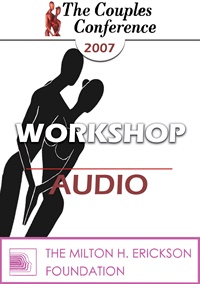CC07 Workshop 01 - Getting to the Heart of It: How to Change Couples Quickly, Dramatically, and Permanently - Terry Real, LICSW
- Average Rating:
- Not yet rated
- Topic Areas:
- Workshops | Couples Therapy | Relational Life Therapy Model (RLT)
- Categories:
- Couples Conference 2007 | Couples Conference | Pioneers in Couples and Family Therapy
- Faculty:
- Terry Real, LICSW
- Duration:
- 2:33:29
- Format:
- Audio Only
- Original Program Date:
- Apr 27, 2007
- License:
- Never Expires.
Description
Description: Outlines a dynamic approach to couples therapy centered on relational empowerment, individual accountability, and emotional balance. Focuses on transforming patterns of grandiosity, shame, love avoidance, and addiction through strategic interventions. Introduces tools like the Relational Grid and emphasizes building relational skills, setting boundaries, and guiding clients toward deeper connection, emotional growth, and mutual cherishing.
Syllabus Description: Learn the three key elements of Relationship Empowerment Therapy: The use of leverage; Attention to "clean-up" issues; The relationship grid. Participants will be introduced to techniques to help partners learn: Where they are stuck in their relationship; What "unfinished business" fuels their "stuckness;" The consequences of not changing, as well as the opportunities for change; How to get from where they are to where they need to be.
Educational Objectives:
- To name three conditions for effective change.
- To describe how to use the relationship grid as a diagnostic tool.
*Sessions may be edited for content and to preserve confidentiality*
Credits
Handouts
| Timestamped Transcript (768.7 KB) | 16 Pages | Available after Purchase |
| Timestamped Transcript (796.2 KB) | 17 Pages | Available after Purchase |
| Timestamped Transcript (826.8 KB) | 18 Pages | Available after Purchase |
Faculty

Terry Real, LICSW Related Seminars and Products
Terry Real, LICSW, is a nationally recognized family therapist, author, and teacher. He is particularly known for his groundbreaking work on men and male psychology as well as his work on gender and couples; he has been in private practice for over twenty-five years. Terry has appeared often as the relationship expert for Good Morning America and ABC News. His work has been featured in numerous academic articles as well as media venues such as Oprah, 20/20, The Today Show, CNN, The New York Times, The Wall Street Journal, Psychology Today and many others.


